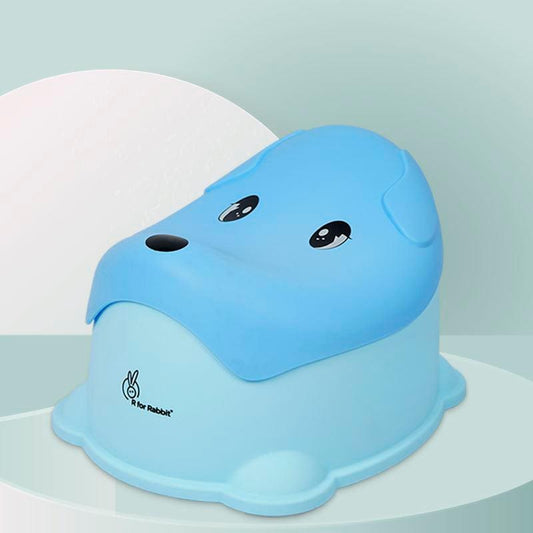How to Prepare a Toddler for Potty Training? A Comprehensive Guide for Indian Parents

Table of Contents
A toddler's success with potty training is significant. It signals the start of independence and self-care. Knowing the need for scheduling and preparation helps parents and children to have a better process.
A child's development relies upon potty training. It assists them with underlining control over their bowel movements and bladder. Accidents can be avoided, and anxiety can be diminished with early preparation. Toddlers become free because of this certainty-helping activity.
Knowing when to start potty training a baby depends on his or her readiness. It is an integral part of toddler potty training preparation. So, it is quite essential to look for signs of readiness and create a supportive climate.
The potty ought to be presented, a routine ought to be established, and patience ought to be displayed to the child. The stage for compelling potty training is established by preparation.
Creating a Positive Potty Training Environment
The process must be seamless and stress-free only from a positive potty training environment. A comfortable space and the appropriate tools must be created.
Your child is encouraged to learn how to toilet train babies in a supportive environment by this environment.
1. Potty Chair or Seat Selection
Choose a potty chair or seat that is appropriate for the comfort and size of your toddler. The proper chair may really make a difference.
Your child will find it appealing, simple to use, and steady. Your toddler will be more willing to start potty training if you have a comfortable potty chair to assist in relieving fears.
2. Arranging a Comfortable Bathroom Area
For your child, make the bathroom a welcoming space. Make sure your toddler can readily reach the potty by placing it in a practical location.
Should a step stool be added, do so. Free from distractions, the bathroom ought to feel safe and cozy. Your child will feel more in control of the potty training process if the space is organized.
3. Presenting Books and Toys Related to the Potty
To make learning enjoyable, introduce toys and books related to potty. Your toddler will benefit from reading books about potty training.
It can be more engaging to use toys that mirror the restroom ritual. The excitement of learning how to begin potty training can be increased by using these tools to lower anxiety.
Establishing a Potty Training Routine
The secret to success is a reliable potty training routine for toddlers. Your toddler will benefit from knowing when and what to expect.
Your child will learn how to efficiently provide toilet training to babies if you establish a routine that makes the procedure smoother and predictable.
4. Developing a Consistent Schedule
Create a regular potty training schedule to get everything rolling. Regular intervals, for example, after waking up, before naps, and after meals, ought to encourage your toddler to utilize the potty.
It is less difficult to start toilet training, assuming your child has a routine that assists them with perceiving when the time has come to go.
5. Incorporating Potty Breaks into Daily Activities
Plan daily activities, including toilet breaks. Before leaving the house, during playtime, or before sleep time, remind your toddler to utilize the potty.
Making toilet breaks a natural part of your day assists you with reinforcing the habit free from pressure.
6. Using Visual Aids and Charts
Chart and visual aids can be utilized to screen progress. Your toddler may be encouraged to utilize the potty all the more habitually with a reward chart with stickers.
Visual reminders for potty training assist your child in grasping their advancement and remaining associated with the routine.
Communication and Language for Potty Training
When potty training, effective communication is essential. Teaching your toddler the appropriate words and encouraging open dialogue about their need’s aids in developing understanding. To make potty training enjoyable, positive reinforcement is crucial.
7. Teaching Bathroom Vocabulary
Teach your toddler some basic potty terminology to start. Words like "potty," "pee," and "poop" enable kids to communicate their requirements.
So that your child can communicate when they need to go, use these words regularly. Starting potty training is easier when the language is clear.
8. Encouraging Open Communication About Bodily Functions
Open communication regarding physical functions is recommended. Tell your child it is normal to discuss the need to use the potty.
Listen to their responses when you routinely ask them if they need to go. They get more comfortable with the potty training process thanks to this open dialogue that creates trust.
9. Using Positive Reinforcement and Praise
Encourage your toddler by using positive reinforcement. Though they do not always succeed, praise them for trying. They can be motivated to keep learning with a straightforward "good job" or a modest reward.
Potty training is made to feel like an achievement by positive reinforcement, boosting your child's self-esteem.
Modeling and Demonstrating Proper Bathroom Behavior
A potent technique to teach your toddler good restroom behavior is by modeling it. You may make potty training simpler to understand by leading by example and demonstrating the steps. Learning can be enjoyable by practicing with dolls or stuffed animals.
10. Leading by Example
Leading by example better teaches your toddler about potty training. Let your child watch you use the toilet. In clear words, explain what you are doing.
They learn that using the potty is a part of daily life by watching you. This approach is quite effective because children frequently learn by imitating their parents.
11. Explaining the Process Step-by-Step
Spend some time thoroughly walking over the potty process step-by-step. Show your toddler how to take down their pants, sit on the potty and clean up after themselves.
As you proceed, explain every step to them. When it is time for them to try, clear instructions make your child feel capable and confident.
12. Practicing with Dolls or Stuffed Animals
Potty training can be entertaining and less intimidating by practicing with dolls or stuffed animals. By leading the doll through the steps, you can demonstrate to your toddler how to teach their toys potty training.
With a relaxed setting, this playful approach aids with your child's comprehension of the procedure. When they attempt potty training on their own, it also encourages them to apply what they have learned.
Dealing with Accidents and Setbacks
Potty training naturally includes accidents and setbacks. Even if your toddler is making progress, it can happen. Your child will continue learning how to give potty training to babies successfully if you remain calm, flexible, and supportive of them.
13. Staying Calm and Supportive
It is critical to be calm and supportive when accidents happen. Steer clear of expressing disappointment or frustration.
Accidents are a part of your child's learning process. Tell them it is normal, then inspire them to try once more. They will feel more confident and less anxious as a result of your good attitude.
14. Cleaning Up Without Shame or Punishment
Without shame or punishment, clean up any spills. Use it to teach your child what to do in the future. If they are willing, gently remind them to use the potty and assist with cleanup.
Without feeling embarrassed or afraid, this method enables students to comprehend the effects of mishaps.
15. Adjusting Strategies as Needed
Adjusting your potty training strategies may be necessary if setbacks happen frequently. Some kids may need different approaches or more time. Be flexible in your approach and give your child your full attention.
You might try delivering more reminders, altering the potty routine, or even taking a short break if necessary. Your child will not feel pressured and will continue to make progress if your strategies are adjusted.
Transitioning Phase from Diapers to Underwear
Transitioning phase from diapers to pants is quite important. It represents the progress and increasing independence of your child. They can comfortably transition to this new stage by following a seamless process.
16. Introducing Training Pants
Introduce training trousers first. Between nappies and pants, these are a beneficial intermediary step. While still offering some protection, training pants allow your toddler to experience wetness. Starting potty training is easy when your child can pull them up and down easily.
17. Gradually Phasing Out Diapers
As your child develops more confidence, gradually stop using nappies. Use nappies only at nighttime or during naps to begin.
As your child improves at using the potty, gradually cut down on daily diaper use. They can change without feeling overwhelmed, thanks to this gradual approach.
18. Celebrating Milestones and Progress
Celebrate the achievements and success of your child. Praise them for using the potty successfully and for wearing knickers.
Positive reinforcement encourages ongoing progress and makes the transition to pants enjoyable. Celebrating these accomplishments gives your child more confidence and enthusiasm for their potty training quest.
Signs and Key Indicators Your Toddler is Ready for Potty Training
At the point when your toddler shows readiness signs, potty training is more effective. Knowing how to start potty training may be made easier by perceiving these signs and key indicators.
To establish a potty training schedule for toddlers, you should initially understand your child's physical, emotional, and behavioral signs.
1) Physical Readiness Indicators
Knowing when to begin potty training depends much on physical readiness. Look for signs like discomfort with dirty nappies, extended periods of dryness, and regular bowel movements.
Your toddler's body appears to be ready to control bowel and bladder functions based on these indicators.
2) Emotional and Cognitive Readiness Signs
Both cognitive and emotional readiness are quite vital. Your toddler should be interested in using the potty and grasp simple instructions.
Your child may be emotionally ready for potty training if she starts to exhibit curiosity about others using the toilet or expresses discomfort with soiled nappies.
3) Behavioral Cues to Watch For
The most obvious signs are typically behavioral cues. Strong indicators that your toddler is ready include starting to tug at their nappy, hiding when they need to go or expressing a desire to be clean. You can begin an effective toilet training regimen for toddlers by watching for these behaviors.
Also Read: Signs Your Child Is Ready For Potty Training
Key Takeaways
Several important steps must be taken to get your toddler ready for potty training. Recognizing readiness signs and establishing a favorable environment are the first steps. Use open communication and establish a consistent routine. Model appropriate behavior and gently manage mishaps.
While commemorating milestones, gradually transition from nappies to pants. Keeping in mind that each child is unique, modify your strategy as necessary. The timing of potty training your child will rely on their readiness and your preparation. Throughout the process, remain supportive and motivate your toddler.
They will feel confident and enthusiastic about this new stage thanks to your upbeat attitude. Potty training can be a rewarding and effective process for both you and your child with careful preparation. Explore R for Rabbit website for more insights on parental care!














